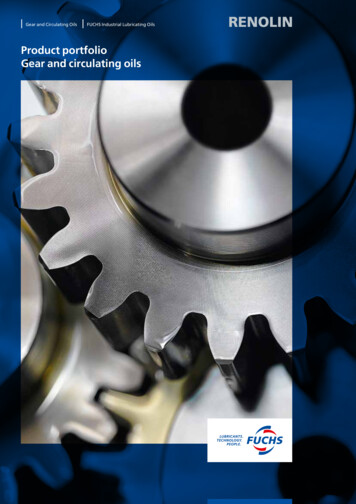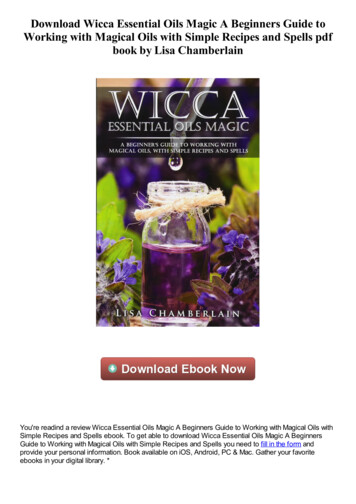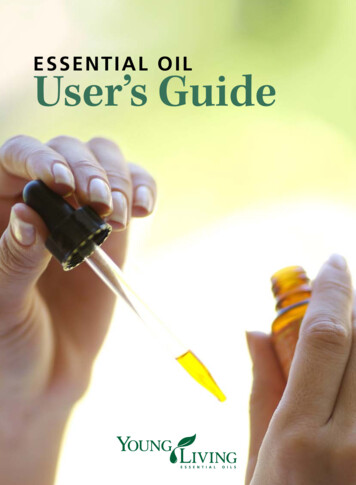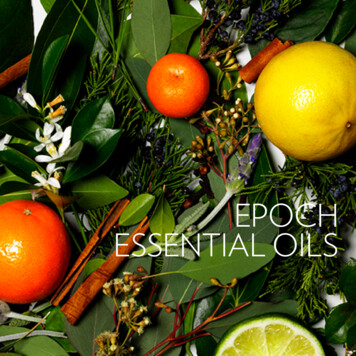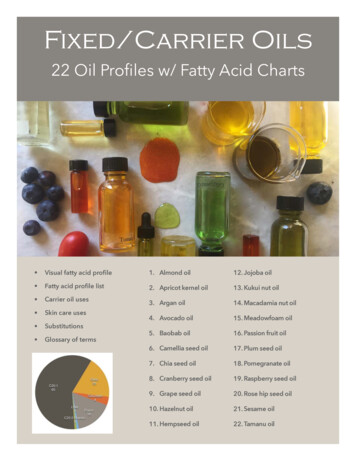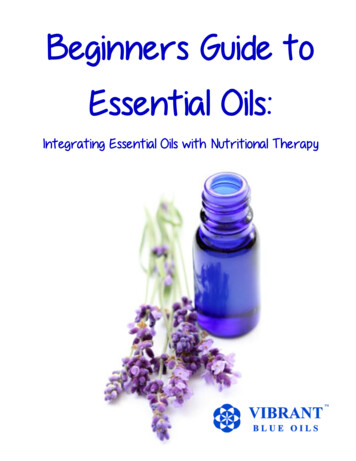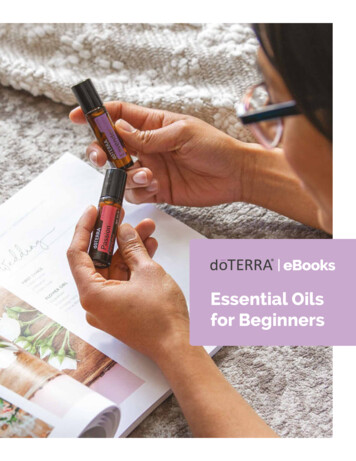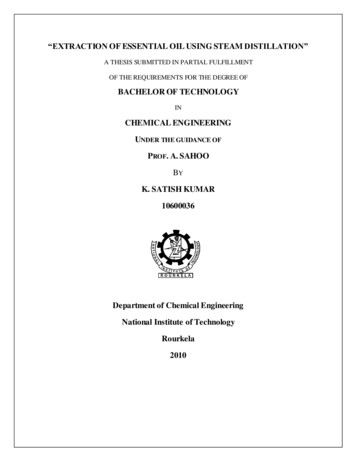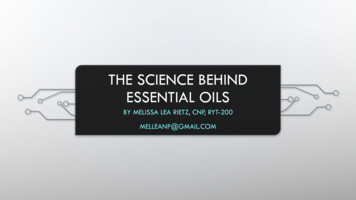
Transcription
THE SCIENCE BEHINDESSENTIAL OILSBY MELISSA LEA RIETZ, CNP, RYT-200MELLEANP@GMAIL.COM
PROFESSIONAL DISCLOSUREI have no personal or professional affiliation with any of the resourceslisted in this presentation, and will receive no monetary gain orprofessional advancement from this lecture.I am a Wellness Advocate for an Essential Oil Company.
TALK OBJECTIVESDescribeIncreaseDiscussIllustrate Describe how essential oils have been used for centuries as pharmacological agents Increase your understanding of the chemical composition of essential oils and how they areextracted for pharmacologic use Discuss how oils can be used internally, aromatically, and topically. Illustrate the chemical make-up, medicinal uses, and potential clinical application of TEATREE, CLARY SAGE, COPAIBA, VETIVER, OREGANO, LEMON, MELISSA, AND LAVENDER.
Plants are able to synthesize two kinds of oils:fixed oils and essential oils Fixed oils are esters of glycerol and fatty acids Essential oils are mixtures of volatile, organicWHAT AREESSENTIALOILS?compounds that originate from a single botanicalsource. These oils create the flavor and fragrance ofthe plant Called “essential” because they are the essenceof the plant It is also believed that in the Middle Agesessential oils were “essential” to life In Modern times essential oils are defined as theessence, or extract, of the plant’s aroma or flavor. Ex. Lavender smells like Lavender because of the oilcontained within the plant
Essential oils are produced as a part of theWHY DOPLANTSPRODUCEESSENTIALOILS?plants immune system, playing a critical rolein protection against environmental threats. Attract Insects Repel Competition Protect Defend & Protect: Provide Immunity Those parts of the plants with the greatestamounts of essential oils are generally theareas that are at the highest risk for aninvasion by microorganisms. This may be thebark, sap, leaves, seeds, or fruit rinds.
PRODUCTION METHODSDistillation:Scent &SteamDistillationvs. Extraction
STEAM DISTILLED Distillation: method of evaporating leading to thecondensing of liquids Can be performed through very simple meansin the fields where the plant is harvested Ability to process large amounts of plantmaterial in a short period of time Highly flammable solvents are not requiredSteam Distilled: Principle of a two-phase distillation asopposed to a regular one-phase distillation Steam is injected into the dry plant material.Due to the very high temperatures thoseconstituents of the plant that have a very highboiling point are extracted This method is almost exclusively used for theindustrial production of essential oils.
STEPS OFSTEAMDISTILLATION1)Steam is created from the boiling point2)The steam passes through the plants biomass, breaking upthe plant micro-particles3)This process separates the volatile from the non-volatileorganic compounds, both rise with the steam4)A condenser is used to cool the steam, thus transforming itback into water5)The volatile principles (i.e. essential oils) rise to the topthrough the use of a separator and are then extracted6)The residual water contains the non-volatile principles, orfloral waters (i.e. hydrosols)which can be used for body careproducts and also contain medicinal properties7)The essential oils are then tested for purity
Plant material is placed in a still and is completelycovered in waterWATERDISTILLEDThe entire still is brought to a boilContinues to be a method used for very high qualityoils as it is performed at reduced pressure andtemperature as compared to steam distillation
The most gentle form of extraction Used exclusively to prepare citrus oils Peels are separated from the fruits and thenCOLDPRESSINGcold pressed The essential oil is collected with mallamounts of juice and then seperatated
Used on raw materials that have a lowconcentration of essential oils Best method for isolating fragrantconstituentsEXTRACTION Solvent Extraction Enfleurage
PURITY Essential oils may be adulterated by extending it with another essential oil that has similar composition It is difficult to detect3 simple tests:a)Additional of vegetable oil is the most common way to extend an essential oil creating a greasyfeel when applied. PURE essential oils do not feel greasy. Apply a small amount to your thumband rub together with you index finger, it should feel smooth not greasy.b)Place a drop of essential oil on a sheet of plain, white paper. A pure oil will completelyevaporate and leave no residue, an extended will leave a lasting, oily stain on the paper.c)Essential oils used for cosmetic purposes sometimes use surfactants and /or emulsifiers, althoughthey claim to be 100% pure. Place 1 drop into water, pure essential oils do not dissolve inwater, they float to the top as they are lighter than water. Emulsified dissolve in the waterproducing a milky white or opaque solution.
QUALITY Pure, natural, and complete Genuine and authentic Natural vs. Synthetic“A truly genuine and authentic essential oil should always be guaranteed inthree respects: the plant, the distillation process, and the essential oil itself.”-Kurt Schnaubelt, Ph. D.
LABELING100%Natural100%Pure100%Complete
USAGE OFESSENTIAL OILSAromaticallyInternallyTopically
SMELLStrong connection between scent and psychological responseResearch demonstrates that basil, lemon, and peppermint arestimulating while bergamot and sandalwood are relaxingMore than 1000 genes code the types of olfactory receptors inour noseReceptors are located on the tips of the olfactory receptor cellsThese receptors are positioned on the upper part of the nasalliningThe body can smell and remember approximately 10,000 smellsAn odor molecule stimulates an odor receptor, which in turnactivates the olfactory receptor cell. An electronic impulse iscreated, then relayed to the glomeruli, then transmitted to thehigher regions of the brain, this signals a response
on
In as little as 5-20 minutes the essential oil is carried into the blood stream,carried to the lungs, and exhaled through the breath. Essential oils are alsoeliminated through the skin and urine.The term “neat”: can be applied without any dilutionTOPICALLYDilute: Essential oils which should be diluted ith a carrier oil every timeSensitive: Require dilution before applying to more sensitive skin such as youngchildren and the elderly.Carrier Oil: an oil that literally acts as a carries the essential oil to the desiredarea, ex. Fractionated coconut oil, avocado oil, jojoba oil
INTERNALLYIn their 1930 publicationUseful Drugs the AmericanMedical Association listedcertain oils for oral use.Pure oils were used fordecades in the food and drinkindustry for flavorings.FDA has created a GenerallyRecognized As Safe (GRAS)list that provides the namesof essential oils that aredeemed as safe for internaluse
Terpenes HydrocarbonsOxygenated Compounds Monoterpene Sesquiterpene Phenols Alcohols Monoterpene alcohols Sesquiterpene NDSKetonesEstersOxidesAldehydesEthers
MONOTERPENE Found in nearly all essential oils Structure of 10 carbon atoms and at least 1 double bond The carbon atoms are derived from two isoprene units React readily to air and heat sources Example: LEMON
MAIN CHEMICAL COMPONENTS: LIMONENE, S pinenes, Γ-TERPIMENE:LEMON ESSENTIAL OIL IS EXTRACTED FROM THE LEMON RINDS, OR PEEL OF THELEMON. THE LEMON RINDS ARE COLD PRESSED TO PRODUCE LEMON ESSENTIALOIL. AN EXPRESSION DISTILLATION PROCESS, COLD PRESSING IS TYPICALLYUSED FOR CITRUS OILS WHEN PRODUCING ESSENTIAL OILS, AND USES HIGHMECHANICAL PRESSURE TO PRODUCE OIL FROM THE LEMON RIND.
HistoryLEMON Lemon trees are native to Asia, they may have arrived inEurope in the Middle Ages around 200 A.D. English sailors inthe Royal Navy used them to protect against vitamindeficiencies given their known benefits as an antiseptic andanti-bacterial agent Used for thousands of years in Ayurvedic Medicine.Botanical Name: Citrus x limon L.Botanical synonym: Citrus limonum RissoFamily: RutaceaeSource: Fruit peel, by expressionKey Constituents:( )-Limoneneβ-pinene
MEDICINAL USE & CLINICAL APPLICATION Antiseptic-like properties Contains compounds studied for their effect onimmune function Limonene slightly inhibits Phase 1 liverdetoxification enzymes, thus induces Phase 2enzymes. Selectively inhibits reproduction of tumor cellsthrough the inhibition of HMG CoA reductase*** this same process occurs when we eat citrusfruits or use Lemon Essential Oil*** May serve as insect repellent May be beneficial to the skin May reduce nausea and vomiting inpregnancy (inhalation)***CITRUS OILS SHOULD NOT BE APPLIED TOSKIN THAT WILL BE EXPOSED TO DIRECTSUNLIGHT OR ULTRAVIOLET LIGHT WITHIN 72HOURS***
LEMON RESEARCHThe effect of lemon inhalation aromatherapy on nausea andvomiting of pregnancy: a double-blinded, randomized,controlled clinical trial.https://www.ncbi.nlm.nih.gov/pubmed/?term lemon essential oil nausea and vomitingThe effect of lemon, orange and bergamot essential oils and theircomponents on the survival of Campylobacter jejuni, Escherichiacoli O157, Listeria monocytogenes, Bacillus cereus andStaphylococcus aureus in vitro and in food 53Effects of sub-minimum inhibitory concentrations of lemonessential oil on the acid tolerance and biofilm formation ofStreptococcus 0Induction of apoptosis in human cervical carcinoma HeLa cellsby polymethoxylated flavone-rich Citrus grandis Osbeck(Dangyuja) leaf 32
SESQUITERPENE Work as a liver and gland stimulant Contain caryophyllene and valencene Composed of 15 carbon atoms derived from 3 isoprene unit Less volatile than Monoterpenes Example: Copaiba
MAIN CHEMICAL COMPONENTS: CARYOPHYLLENE, A BICYCLICSESQUITERPENECOPAIBA ESSENTIAL OIL IS OBTAINED BY STEAM DISTILLATION OF THERESIN COLLECTED FROM COPAIFERA OFFICINALIS, A TREE NATIVE TOCENTRAL AND SOUTH AMERICA.
HistoryCOPAIBA Used since the16th century by native and traditionalmedical practitioners in its native Brazil and throughoutSouth AmericaHarvested from the trunk of the Copaifera tree. Theessential oil is the distilled resin of the treeBotanical Name: Copaifera langsdorfii, Copaifera officinalisFamily: FabaceaeSource: Balsam from woodKey Constituents:β-CaryophylleneGermacrene BHas no known hazards or contraindications
MEDICINAL USE & CLINICAL APPLICATION Bicyclic sesquiterpene beta-caryophyllenehas the ability to bind to CB2 receptors beta-caryophyllene has been known to be acannabinoid Activation of CB2 receptors Copaiba essential oil is composed of morethan 50% beta-caryophylleneThus supports healthy nervous and immunefunction As an anti-oxidantTo support the nervous systemFor the treatment of acneWound and scar healing
COPAIBA RESEARCHApplication of the essential oil from copaiba (Copaiferalangsdori Desf.) for acne vulgaris: a double-blind, placebocontrolled clinical trial.https://www.ncbi.nlm.nih.gov/pubmed/?term Application of the essential oil from copaiba (Copaifera langsdori Desf.) for acne vulgaris%3A a double-blind%2C placebocontrolled clinical trial%2CAntibacterial Combination of Oleoresin from Copaiferamultijuga Hayne and Biogenic Silver Nanoparticles TowardsStreptococcus rm Antibacterial combination of oleoresin from Copaifera multijuga Hayne and biogenic silver nanoparticles towards Streptococcus agalactiaeAntimicrobial Activity of Copaiba (Copaifera officinalis) andPracaxi (Pentaclethra macroloba) Oils againstStaphylococcus Aureus: Importance in Compounding forWound Care.https://www.ncbi.nlm.nih.gov/pubmed/27125055
PHENOLS Subtype of alcohols An alcohol group (an oxygen and a hydrogen) attached to a benzene ring Benzene ring has six carbon atoms arranged in a hexagon pattern with 3double bonds inside the ring Hepato-toxicity Example: Oregano
MAIN CHEMICAL COMPONENTS: CARVACROL, THYMOL , PARA-CYMENE, ΓTERPINENEORIGANUM VULGARE, IS A BUSHY PERENNIAL THAT IS PART OF THE LAMIACEAEFAMILY. THE LEAVES OF THE PLANT ARE FRAGRANT AND ARE CHARACTERIZED BYTHEIR ROUNDED TO OVATE SHAPE. IT THRIVES IN FULL SUN. THE OIL ISEXTRACTED FROM THE LEAVES OF THE PLANT.
HistoryOREGANO Used since the16th century by native and traditionalmedical practitioners in its native Brazil and throughoutSouth America Harvested from the trunk of the Copaifera tree. Theessential oil is the distilled resin of the treeBotanical Name: Origanum onites L.; Origanum vulgare L. subsp.hirtum; Thymbra capitatusFamily: LamaiceaeSource: Dried aerial parts of the flowering plantKey icated in pregnancy and breastfeeding, caution with topicaluse if hypertensive, sensitive skin, and children under the age of 2.
MEDICINAL USE & CLINICAL APPLICATION Main chemical component is carvacrol whichcontains warming propertiesAntiseptic properties due to carvacrolAs a phenol oregano also has beneficialantioxidant effects Antiseptic Carvacrol may help support the body’snormal immune response to inflammatorystressor May promote gastrointestinal healthAnti-bacterialContain high levels of oxygenatingmolecules and have antioxidant properties
OREGANO RESEARCHAntimicrobial activity of carvacrol: current progress and bmed/22044355Antioxidant and Antimicrobial Activities of Essential Oils Obtainedfrom Oregano (Origanum vulgare ssp. hirtum) by Using DifferentExtraction 9/jmf.2010.0098Chemical composition and bioactivity of different oregano(Origanum vulgare) extracts and essential tioxidant, Antibacterial, and Cytotoxic Activities of the EthanolicOriganum vulgare Extract and Its Major les/PMC4804097/
MONOTERPENE ALCOHOLS Any molecule with an alcohol functional group An oxygen atom bound to both the carbon backbone on one end and ahydrogen atom on the other end Example: Tea Tree and Lavender
MAIN CHEMICAL COMPONENTS: LINALOOL, LINALYL ACETATEA SHORT SHRUB THAT GROWS TO BE ROUGHLY 2 FEET TALL, LAVENDER ISNATIVE TO THE MEDITERRANEAN. THE DISTINCT, FRESH SCENT OF LAVENDERCOMES FROM THE PLANT’S FLOWERS, WHICH IS WHERE THE ESSENTIAL OIL ISEXTRACTED FROM. AFTER EXTRACTION, LAVENDER ESSENTIAL OIL IS PRODUCEDTHROUGH THE PROCESS OF STEAM DISTILLATION.
LAVENDERHistory The name lavender comes from the Latin root lavare, which means "to wash.“ Prior to World War 1 Lavender essential oil was only produced from wild plants grown in the French andItalian AlpsThere is documented use of Lavender for more than 2500 years.Used in cosmetics in Egypt, in Greece and Rome as an antiseptic, and ingested internally during the MiddleAges.Botanical Name: Lavandula angustifoliaFamily: LamaiceaeSource: Flowering TopsKey Constituents:Linalyl actetateLinaloolNon-toxic, low risk of skin sensitivityNo known contraindications
MEDICINAL USE & CLINICAL APPLICATION Linolool inhibits HMG CoA reductase(antitumor, antifungal), reduces spasms, isanticonvulsant, and modifies autonomicnervous system activity Linalool may activate biochemical pathways inthe endothelial lining of the blood vessels, thusrelaxing the underlying vascular smoothmuscle. Lavender’s nerve-calming effects may be dueto its ability to modulate NMDA receptors May alleviate premenstrual emotionalsymptoms Anti-bacterial May decrease stress and enhance immunefunction in pregnant women Useful in managing insomnia Active against Staphylococcus aureas,Klebsiella, and Candida albicans making it abeneficial essential oil for a variety of skinconditions
Does lavender aromatherapy alleviate premenstrual emotional symptoms?: a randomized /23724853LAVENDER RESEARCHEffects of Aromatherapy Massage on Pregnant Women's Stress and Immune Function: A Longitudinal,Prospective, Randomized Controlled Inhaled lavender effect on anxiety and pain caused from intrauterine device m lavender iudAntinociceptive and gastroprotective effects of inhaled and orally administered Lavandula hybridaReverchon "Grosso" essential oil.https://www.ncbi.nlm.nih.gov/pubmed/?term Antinociceptive and gastroprotective effects of inhaled and orally administered Lavandula hybrida Reverchon Grosso essential oilLinalool Affects the Antimicrobial Efficacy of Essential Oils.https://www.ncbi.nlm.nih.gov/pubmed/?term Linalool Affects the Antimicrobial Efficacy of Essential OilsEffect of Inhaled Lavender and Sleep Hygiene on Self-Reported Sleep Issues: A Randomized d/?term Effect of lavender and sleep hygiene on selfreported sleep issues%3A A randomized controlled trial.Ambient odors of orange and lavender reduce anxiety and improve mood in a dental office.https://www.ncbi.nlm.nih.gov/pubmed/?term Ambient odors of orange and lavender reduce anxiety and improve mood in a dental office.Effect of lavender aroma on salivary endocrinological stress markers.https://www.ncbi.nlm.nih.gov/pubmed/?term Effect of lavender aroma on salivary endocrinological stress markers.
MAIN CHEMICAL COMPONENTS: TERPINEN-4-OL, Y-TERPINENEMELALEUCA OIL, OR TEA TREE OIL, IS EXTRACTED FROM THE LEAVES OFMELALEUCA SHRUBS OR TREES, WHICH HAVE A STRONG AROMAWHEN RUBBED. MELALEUCA ESSENTIAL OIL IS PRODUCED THROUGHTHE PROCESS OF STEAM DISTILLATION.
TEA TREEHistory Used by the Aboriginal people of Australia for centuries“Discovered” by British explorer Captain James Cook (1728- 1779) on his travelsaround the worldUsed in military first aid kits during World War IIClassed as a necessary commodity in AustraliaBotanical Name: Melaleuca alternifoliaFamily: MyrtaceaeSource: LeavesKey Constituents:Terpinen-4-oly-TerpineneNon-toxic, low risk of skin sensitivity.
MEDICINAL USE & CLINICAL APPLICATION Terpinen-4-ol has a strong 5 carbon bondwhich is chemically resilient against bacteria,it prevents bacteria from reproducing The water-soluble components of tea tree oilcan suppress pro-inflammatory mediatorproduction by activated human monocytes. Terpinen-4-ol and alpha-terpineol cansuppress the production of inflammatorymediators in LPS-stimulated humanmacrophage Potent topical antiseptic, known as a antifungal, antiviral and antibacterial aid May be effective at reducing the appearanceof skin concerns Likely has a place in oral hygiene to keepteeth, gums, and mouth clean and free ofdisease
TEA TREE RESEARCHInfluence of melaleuca and copaiba oils on Candidaalbicans adhesion.https://www.ncbi.nlm.nih.gov/pubmed/?term Influence of melaleuca and copaiba oils on Candida albicans adhesionMelaleuca alternifolia (Tea Tree) Oil: a Review ofAntimicrobial and Other Medicinal s/PMC1360273/Plants of the Melaleuca Genus as Antimicrobial Agents:From Farm to 167Efficacy of Specific Plant Products on MicroorganismsCausing Dental 9
ALDEHYDES Highly reactive Characterized by the group C-H-O (Carbon, Hydrogen, Oxygen) Anti-infectious with a sedative effect on the central nervous system Quite irritating when applied topically, calming effect when inhaled Example: cinnamon
MAIN CHEMICAL COMPONENTS: EUGENOL, EUGENOL ACETATE,CINNAMIC ALDEHYDE AND BENZYL BENZOATEA NATIVE TO INDONESIA, BUT CULTIVATED IN SRI LANKA AND INDIA,THE TREE IS RUST-COLORED AND CAN GROW UP TO 15 METERS(45FEET). EXTRACTION: THE LEAVES AND TWIGS OR INNER DRIED BARKARE SUBJECTED TO STEAM DISTILLATION
CINNAMONHistory One of the oldest known aromaticsLongest existing spices in the worldUsed for embalming purposes, medicine and incense throughout Egypt and for flavoringand as an aromatic in religious rites in Europe.Botanical Name: Cinnamomum verum J. Presl.Family: LauraceaeSource: Leaves or BarkKey Constituents:Eugenol (leaf)(E)-Cinnamaldehyde (bark)Eugenyl acetateHigh risk of skin sensitization, contraindicated in pregnancy and breastfeeding. Medication interaction must beconsidered.
MEDICINAL USE & CLINICAL APPLICATION Cinnamaldehyde, which is the main chemicalconstituent of Cinnamon Bark, may support healthymolecular function in the kidneys by inactivating theJAK2-STAT1/STAT3 biochemical pathway in thekidney cells Sirtuin-1 (Sirt-1), a deacetylase in the insulinsignaling pathway is a possible target for cinnamonextract and may be why it has an antidiabeticeffect. Anti-inflammatory properties of cinnamaldehydehave been shown to be caused by it’s ability toblock nuclear factor-κB activation in immune cells Anti-diabetic properties Frequently used as a spicePatients may be using cinnamon as a dietarysupplement for gastrointestinal issues or weight loss
CINNAMON RESEARCHCinnamaldehyde and Nitric Oxide Attenuate Advanced GlycationEnd Products- ‐Induced the JAK/STAT Signaling in Human RenalTubular 02/jcb.25058Cooperative binding of cinnamon polyphenols as activators ofSirtuin-1 protein in the insulin signaling j.31.1 supplement.761.25Immune Suppressive Effect of Cinnamaldehyde Due to Inhibitionof Proliferation and Induction of Apoptosis in Immune Cells:Implications in C4182734/
ESTERS Formed by the reaction of alcohols with acids Central carbon atom double bonded to an oxygen atom, single bonded to thebackbone, and single bonded to a second oxygen atom Used extensively in flavorings and edible fruit aromas Activity against fungal overgrowth Example: Clary sage
MAIN CHEMICAL COMPONENTS: LINALYL ACETATE, LINALOOLCLARY SAGE IS A BIENNIAL OR PERENNIAL HERB THAT IS FASTGROWING. CLARY SAGE ESSENTIAL OIL IS EXTRACTED FROMTHE FLOWER.
CLARY SAGEHistory In the Middle Ages Clary Sage was used to relieve a wide range of gynecological conditions includingmenstrual cramps, painful menstruation, and hot flashesMentioned in herbalist Culpeper’s ‘Complete Herbal & English Physician’ (1653), clary sage wasreferred to as ‘clear eye’ as after soaking the seeds form a thick mucilage that were used to removeforeign objects from the eye, draw out splinters and thorns from the skin, and reduce inflammation.Native to Southern EuropeBotanical Name: Muscatel sageFamily: LamiaceaeSource: Leaves and flowering topsKey Constituents:Linalyl acetateLinaloolGermacrene DNon-toxic, Moderate risk of skin sensitization, No known contraindications.
MEDICINAL USE & CLINICAL APPLICATION Active against Staphylococcusaureus, S. epidermidis and S. xylosus Massage with Clary Sage providedrelief for primary dysmenorrheaand reduced the duration ofmenstrual pain May be of benefit to women inmenopause May be effective adjunct in thetreatment of depression Shows promise as an antimicrobialagent
CLARY SAGE RESEARCHRandomized controlled trial for Salvia sclarea or Lavandula angustifolia:differential effects on blood pressure in female patients with urinaryincontinence undergoing urodynamic 360656Changes in 5-hydroxytryptamine and cortisol plasma levels in menopausalwomen after inhalation of clary sage tidepressant-like effect of Salvia sclarea is explained by modulation ofdopamine activities in he effect of clary sage oil on staphylococci responsible for wound s/PMC4360007/
ETHERS A molecule with an oxygen atom bonded betweentwo carbons. The two flanking carbons MUST only have bondswith other carbons Ether eucalyptol or 1, 8-cineole is the mostcommon ether found in essential oils Eucalyptole (usually redistilled or isolated) iswidely used as an expectorant in many over-thecounter pharmaceuticals Example: eucalyptus
MAIN CHEMICAL COMPONENTS: EUCALYPTOL, ALPHA-TERPINEOLTHE EUCALYPTUS PLANT IS AN EVERGREEN TREE THAT CAN GROW UPTO 50 FEET IN HEIGHT. EUCALYPTUS LEAVES ARE THIN, LONG, ANDGREEN IN COLOR. EUCALYPTUS ESSENTIAL OIL IS EXTRACTED FROMTHE LEAVES.
EUCALYPTUSHistory Originally grown in Australia and known by the native population of Australia as ‘kino’,used to cover wounds and assist in healing Introduced in Europe in 1788The first major use of Eucalyptus in the Industrialized world was as an antiseptic agentBotanical Name: Eucalyptus camaldulensis; Eucalyptus globulus; Eucalyptus maidenii; Eucalyptus plenissima; Eucalyptuspolybractea; Eucalyptus radiata; Eucalyptus smithiiFamily: MyrtaceaeSource: LeavesKey Constituents:1, 8-Cineolea-PineneA-TerpineolMay cause breathing and CNS problems in young children. DO not apply near the face of an infant or children underthe age of 10.
MEDICINAL USE & CLINICAL APPLICATION Eucalyptus is a mucolytic, and as such hasbronchodilating and anti-inflammatory effects Broad-spectrum antimicrobial Application by inhalation or oral routeprovides benefit for purulent and non-purulentrespiratory problems Eucalyptus oil has been shown in studies tosignificantly induced macrophage activationand reduce the release of inflammatorycytokines Used as an anti-inflammatory, anti-fungal,and antimicrobial agent Studies to demonstrate the efficacy of the usein Eucalyptus in the treatment of asthma andCOPD are ongoing
EUCALYPTUS RESEARCHConcomitant therapy with Cineole (Eucalyptole) reducesexacerbations in COPD: a placebo-controlled doubleblind trial.https://www.ncbi.nlm.nih.gov/pubmed/?term Concomitant therapy with Cineole (Eucalyptole) reduces exacerbations in COPD%3A a placebo-controlled doubleblind trial.Patients with asthma benefit from concomitant therapywith cineole: a placebo-controlled, double-blind trial.https://www.ncbi.nlm.nih.gov/pubmed/?term Patients with asthma benefit from concomitant therapy with cineole%3A a placebo-controlled%2C double-blind trial
KETONES All ketones share the same functional group: the ketone or carboxyl group Most prominent feature is their mucolytic effect Ability to induce the formation of new cells and tissue Possibly neurotoxic when isolated from constituents Example: Spikenard
ESSENTIAL OILS MIGHT BE THE NEW -oils/384247/
MAIN CHEMICAL COMPONENTS: CARVONE, ISOVALENCENOL,KHUSIMOLTHE VETIVER PLANT, VETIVERIA ZIZANIOIDES, IS A MEMBER OF THEGRASS FAMILY. THE MANY ROOTS OF THE PLANT GROW IN LARGECLUSTERS UNDERGROUND. THE VETIVER ESSENTIAL OIL IS OBTAINEDFROM THE ROOTS OF THE VETIVER PLANT.
VETIVER RESEARCHVetiver Essential Oil in Cosmetics: What Is New?https://www.ncbi.nlm.nih.gov/pubmed/28930256
RESOURCES Essential Oil Safety by Robert Tisserand &Rodney Young The Healing Intelligence of Essential Oils byKurt Schaubelt Emotions & Essential Oils Aromatica by Peter Holmes Medical Aromatherapy by Kurt Schaubelt
essential oils were “essential” to life In Modern times essential oils are defined as the essence, or extract, of the plant’s aroma or flavor. Ex. Lavender smells li
